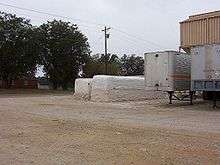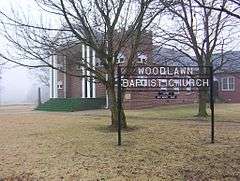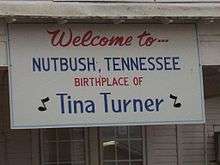Nutbush, Tennessee
| Nutbush, Tennessee | |
|---|---|
| Unincorporated community[1] | |
 | |
|
Location in the state of Tennessee | |
| Coordinates: 35°41′53″N 89°24′29″W / 35.69806°N 89.40806°WCoordinates: 35°41′53″N 89°24′29″W / 35.69806°N 89.40806°W | |
| Country | United States |
| State | Tennessee |
| Counties | Haywood |
| Elevation | 358 ft (109 m) |
| Population (2000) of the Nutbush voting precinct | |
| • Total | 259 |
| Time zone | CST (UTC-6) |
| • Summer (DST) | CDT (UTC-5) |
| ZIP code | 38063 (Ripley, Tennessee)[2] |
| Area code | 731 |

Nutbush is a rural unincorporated community in Haywood County, Tennessee, in the western part of the state.[1]
Established in the early 19th century, Nutbush is home to two early American churches founded by white settlers, Woodlawn Baptist Church and Trinity United Methodist Church. More than 50 Civil War soldiers are buried in Trinity Cemetery.
Agriculture is the dominant source of income in the area, focused on the cultivation and processing of cotton. As of 2006, cotton was processed in one cotton-processing plant in the community.
Nutbush is best known as the birthplace and childhood home of singer Tina Turner, who described the town in her 1973 song "Nutbush City Limits". In 2002, a segment of Tennessee State Route 19 near Nutbush was named "Tina Turner Highway" in her honor.[3][4][5] Bob Seger has also recorded popular versions of "Nutbush City Limits." The song appears on his 1975 Beautiful Loser LP and it is also the opener on his 5x Platinum-selling live record, Live Bullet.
Nutbush is also the birthplace and home town of pioneer musicians and recording artists such as Hambone Willie Newbern and Sleepy John Estes.[6]
Demographics
In 2000, the population of the Nutbush voting precinct (TN 3976) was 259. Of those, 215 were White (83.01%), 42 Black (16.22%), and 2 were of another ethnicity (0.77%). At that time 190 people (73.36%) were aged 18 or older.[7]
Economy

The community's main source of income is agriculture (especially cotton).
After the abolition of slavery, sharecropping was the primary means of income for low income families in the area. Land would be used by sharecroppers, mostly for growing cotton, in return for a share of the crop to the landowner.
Modern machines such as the cotton picker have superseded manual cultivation. As of 2006, one cotton-processing plant in Nutbush is the only agricultural industry in the community.
Lagoon Creek Peaking Facility is run by the Tennessee Valley Authority (TVA) in Nutbush. From eight gas turbines, the power plant generates electric power for the area in times of high demand.[8][9]
History
Settlement

The Nutbush community was established in the early 19th century by settlers from Virginia and North Carolina. Originally from England they traveled westward to Tennessee hoping to gain economic prosperity through the use of slave labor.[10]
Churches
Trinity United Methodist Church
Trinity United Methodist Church was founded in 1822. More than 50 Civil War soldiers, both Confederate and Union soldiers, are buried in the Trinity Cemetery associated with the church. The Trinity Cemetery is mentioned as one of the best kept cemeteries in the county.[11]
Woodlawn Baptist Church

The Woodlawn Missionary Baptist Church in Nutbush was established in 1866 by freed slaves of the community and members of the white Woodlawn Baptist Church. Most slave congregations were ministered by white pastors but in 1846, the young slave Hardin Smith of Virginia was allowed to preach to a slave congregation at the white Woodlawn Church, establishing the first area congregation pastored by a slave.[10][12]
Woodlawn Baptist Church was added to the National Register of Historic Places in 1996 for its historical significance.[13]
Postal
In 1881 a U.S. Post office was opened in Nutbush and closed in 1905.[14]
Geography
Nutbush is located at 35°41′53″N 89°24′29″W / 35.69806°N 89.40806°W (35.6981330, -89.4081280), at an elevation of 358 feet (109 m).[1]
Cotton fields and hills dominate the landscape of the surrounding area.
Nutbush is situated on the Southeastern edge of the New Madrid Seismic Zone, an area with a high earthquake risk.
Postal and telephone
The U.S. ZIP Code for Nutbush is 38063 (Ripley, Tennessee)[2] and the telephone area code is 731.[15]
Music
The early Black musicians and singers from the Nutbush churches recorded and influenced an international audience.[6]
Pioneer musicians
Nutbush is the birthplace and home community of black and white pioneer musicians and prominent recording artists such as Hambone Willie Newbern and Sleepy John Estes. Harmonica player Noah Lewis of Henning, Tennessee is buried in an area cemetery near Nutbush.[6]
Tina Turner

Nutbush is best known as the childhood home of singer Tina Turner. At age 16, she moved to St. Louis, Missouri.
After her birth in 1939, Tina Turner (born Anna Mae Bullock) was raised in Nutbush, Brownsville and Ripley by her grandmother and extended family in the area. The houses she was raised in as a child no longer exist. Wood from her Nutbush/Flagg Grove home was converted into a barn.[16]

Both Woodlawn Missionary Baptist Church and Spring Hill Baptist Church in Nutbush were the family churches of Tina Turner. She attended and sang in both choirs growing up. Her family members were church officials, musicians and singers who are buried in both cemeteries.[16]
Tina Turner's song "Nutbush City Limits" (1973, produced by Ike Turner) is about the town where she was born and raised: Nutbush, Tennessee. The line dance "The Nutbush" is performed to the song "Nutbush City Limits".
In 2002, Tennessee State Route 19 between Brownsville and Nutbush was officially designated "Tina Turner Highway ".[3][4][5]
Nutbush is mentioned on the TV show Brainiac: Science Abuse. An impersonator of Tina Turner is introduced as "Tina Turner and her Bunsen Burner". With different explosive materials she destroys cars like she "used to do in her lab in Nutbush".
References
| Wikimedia Commons has media related to Nutbush, Tennessee. |
- 1 2 3 U.S. Geological Survey Geographic Names Information System: Nutbush, Tennessee
- 1 2 http://www.downloadzipcode.com/ DownloadZIPcode
- 1 2 Wilder, John S. (January 17, 2002). "SB 2798: Highway Signs - "Tina Turner Highway"" (PDF). Legislation Archives - Bills and Resolutions: 102nd General Assembly. Nashville, TN: Tennessee Senate. Retrieved June 26, 2010.
- 1 2 Fitzhugh, Craig (January 22, 2002). "HB 2535: Highway Signs - "Tina Turner Highway"" (PDF). Legislation Archives - Bills and Resolutions: 102nd General Assembly. Nashville, TN: Tennessee House of Representatives. Retrieved June 26, 2010.
- 1 2 Associated Press (September 25, 2002). "Highway to Be Named for Tina Turner". AP Online News Wire. Retrieved June 26, 2010.
- 1 2 3 A History of Tennessee Arts, University of Tennessee Press
- ↑ http://www.comptroller.state.tn.us Tennessee Comptroller of the Treasury
- ↑ http://www.continentalconst.com/ Continental Construction, Co., Inc.
- ↑ http://www.atlaspower.com/ AtlasPower, Inc.
- 1 2 The Tennessee Encyclopedia of History and Culture, Rutledge Press
- ↑ http://www.rootsweb.com Rootsweb - Haywood County, TN Genealogy
- ↑ Norris, Sharon, Black America Series: Haywood County Tennessee, Arcadia Publishing
- ↑ http://www.nationalregisterofhistoricplaces.com National Register of Historic Places
- ↑ http://www.state.tn.us/TSLA/ Tennessee State Library and Archives
- ↑ http://www.bellsouth.com BellSouth
- 1 2 Information by Sharon Norris, national preservationist, author and researcher of Black America Series: Haywood County Tennessee; relative of Tina Turner and native of Nutbush
Further reading
- West, Carroll Van & Duncan Binnicker, Margaret (2004). A History of Tennessee Arts. Knoxville, TN: The University of Tennessee Press. ISBN 1-57233-239-5.
- Norris, Sharon (2000). Black America Series: Haywood County Tennessee. Mount Pleasant, SC: Arcadia Publishing. ISBN 0-7385-0605-2.
External links
- Photographic Documentation of contemporary Nutbush, Tennessee.
- The Goodspeed History Haywood County, Tennessee, 1887
- The Tennessee Encyclopedia of History and Culture